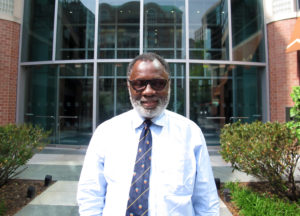
An interview with Murtada Sesay, country project director in Sierra Leone. SIAPS is working on a two-year project funded by USAID to help rebuild and strengthen the country’s pharmaceutical system following the Ebola epidemic.

What’s SIAPS doing in Sierra Leone?
Our systems strengthening project there was a consequence, not only of the more recent Ebola, but also the earlier country’s 10-year civil war, which decimated its health system infrastructure. When Ebola struck, health system workers, including those in the pharmaceutical sector, died or became ill and/or deserted the facilities. Also, there was ineffective oversight, with poor or confusing communication from the central government, so nobody seemed to be quite clear on what to do.
The system strengthening project was to help revamp and restructure the health products supply chain, particularly in the districts and peripheral health facilities, which felt the most impact from Ebola. So the USAID/SIAPS Project worked with the central government to organize its health leadership structure, introduce a new peripheral health facility performance-monitoring process to identify problems with the medicines supply chain and collect quality information for appropriate decision making.

Can you talk about how the emergency context changed the project?
It brought to light the things that were weak in the pharmaceutical sector before Ebola. If you look at the epidemic, there were a lot of problems—not knowing where the pharmaceutical products were, why they weren’t getting to people, and who needed them. Once these issues were corrected, the mortality and morbidity started coming down. So we hope the SIAPS intervention will be a lesson for the future. Now people are more sensitized as to how to handle a crisis. Disease outbreaks will still happen, unfortunately.
What could be done differently next time?
Better messaging. With Ebola, the initial message was, “Ebola kills.” People obviously thought that if it kills, why should I go to the hospital? Later the messaging was changed to: “Rush to the hospital. Your life could be saved.” The fact of Ebola was the same, but that messaging helped. Also, countries need to know where stocks are. Before Ebola, the medical stores were in poor shape, so the supply of existing medicines was erratic, including critical intravenous drips. Good stock management helps during an epidemic.
An early information capture and reporting system helps to identify and manage risks. For example, there was overlooked evidence that an Ebola outbreak was emerging. If you read the literature on the Ebola outbreak from sources in Sierra Leone, you may find conflicting dates of when the epidemic actually began, maybe because many communities were in denial. More attention and follow-up should have been paid to informal news of Ebola in Guinea and a mysterious death in a border town—a young boy who was likely the first to die from it. Now, people have learned their lesson, as we can see with the early attention to ruling out subsequent claims of a recurrence of Ebola in Liberia, and now, also, with the rapid and effective response in the DRC.
Have lessons learned helped strengthen Sierra Leone’s health system going forward, even beyond Ebola response? Can we say the country has a strong pharmaceutical system now?
Without a doubt. The structure is more responsive to issues. Our intervention was not fragmented; it’s a full intervention across the supply chain, including all aspects of the pharmaceutical system structure. Before, response from partners was largely fragmented—go to one district and look at storage, go to another and look at renovating a few health facilities. This program looks at all the issues in a comprehensive way. Above all, we have seen how the responsibility from the central level has improved—there’s routine engagement and communication. That should continue.

